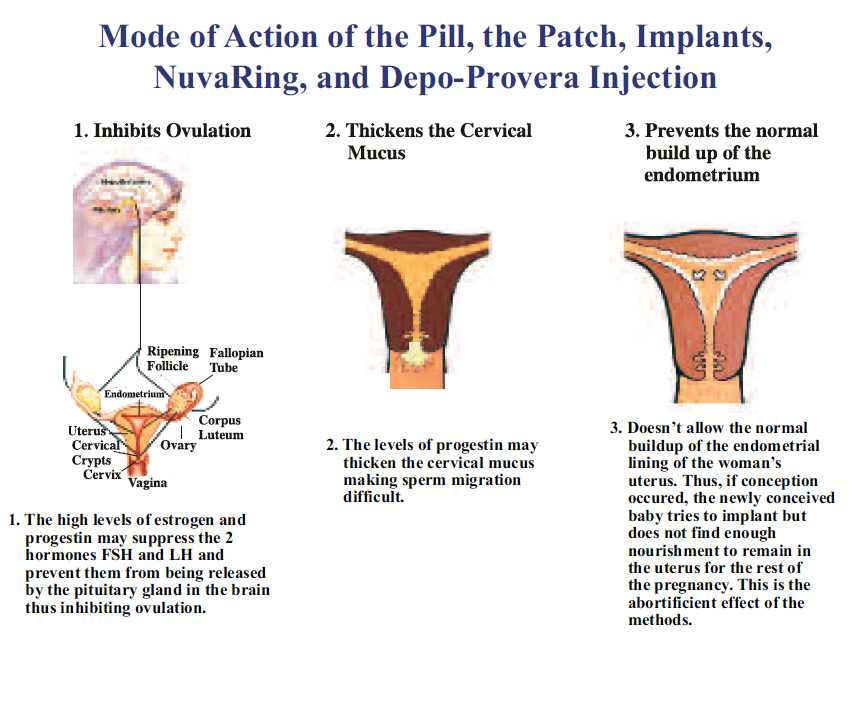Today there are many diverse methods of artificial birth control available on the worldwide market. The most commonly used method still comes in pill form.
Methods of Operation
Birth control pills have three distinct mechanisms:
1) May Suppress Ovulation: A woman ovulates when her pituitary gland, located at the base of the brain, releases hormones that stimulate her ovaries to discharge an ovum (egg). The Combination Pill may interrupt the release of these pituitary hormones, preventing the ovaries from releasing an ovum. Without an ovum available for conception, a woman has been essentially rendered chemically sterile.
2) May Impede Sperm Migration: Before a woman ovulates her cervix produces mucus through which sperm migrate to meet the ovum. The mucus also provides nourishment to sustain the life of the sperm. When a woman is under the influence of progestin the mucus thickens, which impedes sperm migration.
3) May Inhibit Implantation: If the Pill fails to prevent pregnancy with one of the first two actions, the union of the ovum with the sperm (conception) will result in the creation of human life. Five to six days later this new human being will attempt to implant in the endometrium (the lining of the uterus). The progestin component of the combination and mini pill causes the lining of the uterus to be thin, which makes it inhospitable to the newly conceived life. This leads to a chemically-induced miscarriage (abortion).

Prolonged use of artificial birth control sometimes results in infertility. For example, the Pill causes 150 chemical changes in the woman's body.
 How the pill kills? The ways the pill kills:
How the pill kills? The ways the pill kills:
1. They cause your blood to clot

2. They make it easier to get potentially lethal infections like human papilloma virus (HPV) and human immunodeficiency virus (HIV)
3. They cause cancer: The pill is a known group 1 carcinogen for breast, cervical and liver cancers according to the UN’s International Agency on Research of Cancer (IARC).
- Since 1975, the risk of in-situ breast cancer has increased 400% in premenopausal women. Invasive cancers have increased 40% overall in the U.S.
- In 2006, a meta-analysis in the Mayo Clinic proceedings showed a 44% increase risk of breast cancer in women who took the Pill before having a child.
- In 2007, the UN’s International Agency on Research of Cancer (IARC) reported in their Monograph 91 that estrogen-progestin combination drugs (the Pill) were a group 1 carcinogen for breast, cervical and liver cancers.
- In 2009, Dolle showed a 320% increase risk of triple negative breast cancer in women on the Pill. Which is the most difficult and deadly form of breast cancer to treat.
The Pill also causes miscarriages (spontaneous abortions) by acting as an abortifacient
- As is well observed by those on the pill, menstrual periods are light because the pill reduces the thick-ness of the endometrial lining, resulting in difficulty of implantation of the embryo after conception has occurred.
- The pill also results in biochemical changes, such as in the levels of interleukins, which are molecules necessary for implantation.
Extensive information in the book Love and Fertility, pages:





